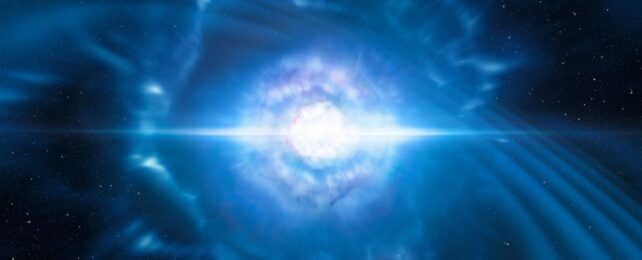Stars at the very dawn of time must have been capable of creating elements far heavier than anything that has ever been found naturally occurring on Earth, or at all in the wider Universe.
That's the conclusion a team of astronomers led by Ian Roederer of the University of Michigan has drawn after examining 42 stars in the Milky Way, the chemical abundances of which can only be explained by the previous production of elements with atomic masses greater than 260.
Most of the elements in the Universe – pretty much anything heavier than hydrogen, really – have been created by stars. The first way they're created is fusion. At the core of a star is basically an engine that mushes atoms together to create heavier elements.
The heaviest element this process can produce is iron. The fusion of iron into heavier elements requires way more energy than it generates, and so at that point the star self-destructs
Another way has to do with that self-destruction. In supernova explosions as a star dies, and kilonova explosions where two neutron stars slam into each other, conditions become just right for rapid neutron-capture process, or r-process.
This is when there are so many loose neutrons floating around that they schloop onto available nuclei, forming a heavier element. It needs a really extreme, energetic environment to happen, such as a supernova.
And it happens really quickly, too – hence the 'rapid' part in the name. This is confirmed to be the process that produces elements like gold, platinum, thorium, and uranium. But there's still a lot we don't know about how elements are created.
"We have a general idea of how the r-process works, but the conditions of the process are quite extreme," Roederer explains.
"We don't have a good sense of how many different kinds of sites in the Universe can generate the r-process, we don't know how the r-process ends, and we can't answer questions like, how many neutrons can you add?
"Or, how heavy can an element be? So we decided to look at elements that could be made by fission in some well-studied old stars to see if we could start to answer some of these questions."
Another way we know that elements can be formed is by nuclear fission. This is when, rather than fusing together, an atom splits apart, and the result is a less massive element.
The chemical compositions of the 42 stars in the Milky Way Roederer and his team looked at have been well studied and established.
The first stars in the Universe were predominantly made up of hydrogen. They created elements in their cores, and died, seeding the surrounding space with elements that were taken up in subsequent generations of stars.
The stars the team studied are known to have elements produced by the r-process during supernova explosions.
But the researchers weren't looking for r-process elements. They were looking for elements that could be products of fission, such as ruthenium, rhodium, palladium, and silver. And, rather than look at the stars individually, as is usually the case, the researchers examined them as a group.
And they found a pattern. The presence of certain other elements is expected in certain abundance ratios if the metals the team looked at were produced by the r-process. Those ratios were not present. This suggests, the team concluded, that the elements in question were produced by fission.
That means the early stars from whence these metals came must have produced elements far heavier, greater than an atomic mass of 260, that subsequently split to form lighter, more stable elements.
We've never observed those elements naturally occurring, anywhere. We've seen them in the lab, but their half-lives are so short that they decay almost immediately.
However, the research shows that looking for their potential fission products could tell us how likely or common their formation might be, out there in the wider Universe.
"That 260 is interesting because we haven't previously detected anything that heavy in space or naturally on Earth, even in nuclear weapon tests," Roederer says.
"But seeing them in space gives us guidance for how to think about models and fission – and could give us insight into how the rich diversity of elements came to be."
The research has been published in Science.
